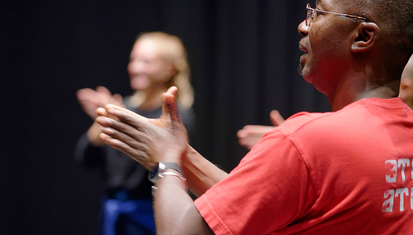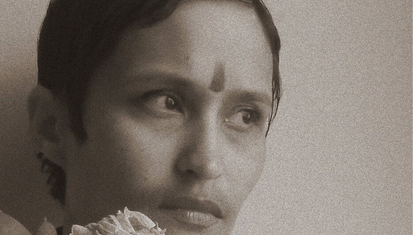It’s no secret that artistic research takes place at the Academy of Theatre and Dance, but what does it actually involve? In this eleventh episode in a series of interviews, we take a look behind the scenes, in conversation with theatre director and performer Nita Liem (Don’t Hit Mama), who teaches at the Dance in Education programme and is a member of the Embodied Knowledge in Theatre and Dance working group.
Part 11: The Body as a Library
Nita Liem: My research actually started more than 30 years ago – I’d just graduated from the Dance Expression teacher training course, and the amateur dance circuit led me to Bijlmer [a suburb of Amsterdam with a large migrant population]. It was still a no-go area at the time, but I was interested in dance trends, and at school I’d been missing the beat, the technique. In Bijlmer I saw a different kind of vibe, one that was spontaneous, raw and vibrant. It was the time of the first breakdance groups, with those classic white gloves and a piece of cardboard. They would perform on Leidseplein, and at that time they wouldn’t get moved on by the police. I was also inspired by what I saw happening on the streets of Bijlmer, such as two children practicing robotics in the rain and looking at their reflection in the bus shelter window. That’s how my work started in 1986 and 87, at a time when street dance and the academy were still separate worlds. From that point on, I always worked with migrant children and their cultures and subcultures. In 2000, Bart Deuss and I founded the dance company Don’t Hit Mama.
You were one of the first people in the Netherlands to take hip-hop and street dance into the theatre. You were the director of your company until 2020. I think it’s really strong that after 20 years you said, we’re stopping Don’t Hit Mama, because our work is done.
Yes, at a certain point we realised that you can only be a pioneer for a limited amount of time [laughs]. We stopped out of love. We realised there was no room for us to develop at the Don’t Hit Mama house. The jacket had got too tight. The biggest challenge was whether we would have the courage put ourselves first. If we let it go, then what? We promised ourselves we would take our time for this, because before you make something happen, you first need to process it. I think the trick is to give back to yourself what you’ve given out.
What are you doing now?
Strangely enough, where I started over 30 years ago and where I am now are not that far apart. I’ve watched my dancers and performers for years as a director, and I’ve always been fascinated by the stories and wisdom they carried in their bodies. I’ve always embraced young people as professionals and experts by experience. Now I’m taking a new starting point: the body as a library, as a vehicle. I’ve seen it in others for years, but what about in me?
In what ways did you see that wisdom in your dancers’ bodies?
These young people are intuitively very wise. You can see it in the speed they learn. As well as copying the form from each other, they replicate muscle tone, attack, dynamics. It’s as if they pass the movements on to each other at the level of their bones or their soul. That’s very different from the way things were at the academy, at the mirror: ‘1, 2, 3, 4’, and so on. Hip-hop always had a desire to be seen, to live. There was fire… I have to say ‘was’, unfortunately, because it’s all a lot smoother and more commercial these days. There was an incredible authenticity and pride in how they moved, which was something I missed on the dance course. It was like they were saying, ‘I own this.’ Those guys had one videotape that would go from hand to hand. It had something almost tribal about it, an object that circulates, from which they got their information.
So they learned everything from their friends?
Yes, on the street, in nightclubs, and from MTV, which was on TV from 1987. That was also an important source. It was a funny time, also in the way they would they correct each other: ‘Come on, come on, somersault, somersault,’ and then they would grab someone and throw them in the air, and it would go OK. There was no warming up first or taking it step by step. I found that very refreshing. There was also a natural order in the group. The one who danced the best had the authority and the biggest mouth, but they would also stick by the little ones who got bullied at school. That was a dynamic, a friendship, that I hadn’t experienced. I think it’s the life that was in it that I really missed, from the moment I arrived here as a child from Indonesia.
You immigrated as a child?
Yes, in retrospect I think there was a good reason I fell in love with Bijlmer [laughs], and I’ve worked with migrant children from the very beginning. I’ve always been interested in social dance, especially Black social dance, and I mean Black in a political sense – where dance creates connection. I met Antillean mums and grandmas who said, ‘I never learned to dance,’ and then I’d say, ‘But you dance, don’t you? That’s salsa, right? How come you can dance like that?’ Then they would say that as a five-year-old they used to stand on their granddad’s feet, and he’d do the steps with them. Their granddad was their first teacher – isn’t that great! I’ve always been interested in that transfer of knowledge. If it takes place within the family, the dance goes hand in hand with grandad’s or grandma’s jokes, and a bowl of soup between time. That’s a completely different way of learning – there’s a wisdom in it. I believe that if you’re nurtured like this, you have a much better idea of who you are.
I gather that when you were about 50, you started doing Javanese dance.
After years of directing and running things, I wanted to dance again – but in what kind of body, in what form? I took a two-month sabbatical in 2010. I travelled to Senegal to do a course with Germaine Acogny. I’d previously taken some students from the Dance in Education programme to her dance centre, in 2008. Germaine is the director of Ecole de Sables, and the studio is in the open air, directly on the sandy ground. For me, seven weeks of walking in the sand became a massage from the inside: the movement of the spine, an experience to the marrow. The workshop ended with a three-minute solo. I realised that with Don’t Hit Mama, I’d always told other people’s stories. What was my story?
Back in the Netherlands, I started taking Sonja Bloem’s lessons in Javanese dance, the dance form from the island where I was born. Germaine Acogny always says, ‘You carry within you the environment in which you were born; you dance with your ancestors.’ I was so homesick at the time, but I didn’t know where or what for. That led to the performance Hometime Attack, in which I was on stage myself for the first time. In the last years of Don’t Hit Mama, we worked on Asian Celebrations, an exhibition and dance performance with an entirely Asian cast.
Someone who has become an important mentor to me in recent years is Kitlyn Tjin A Djie. She’s a Surinamese system therapist, known for her Protective Wraps method. She works a lot with migrant families and the wisdom that emerges when you bring different generations together. One of the things she talks about in her work is the rite of passage, which consists of three phases. With migration or another drastic experience, you let go of the old and familiar, and eventually you find a new path, but in between there’s always an uncertain and vulnerable phase of not knowing, of not having anything to hold on to. That’s the liminal phase, where transition takes place.
I’ve become interested in that transition space, and when I met Kitlyn Tjin A Djie, I said, ‘I’m always the bridge builder, I’m always in between everything else.’ Her answer was this: ‘In between is also a place.’ I’ve come to see the richness of this place – it’s the area where anything is possible, it’s dance or die. It’s where you’re at your most creative. In my view, research groups at the ATD fit well with this. They are safe spaces where you can ask complicated and difficult, searching questions in the presence of other lecturers who do research. They hold up a mirror to you.
I joined the working group Embodied Knowledge in Theatre and Dance last year, just after we’d closed down the Don’t Hit Mama house. There are many questions I’ll be looking for answers to in the coming years, like what should we do with Don’t Hit Mama’s 20-year archive? In what ways is my body also an archive? And where is the wisdom, the ancestral energy? What are the differences between Asian and African American hip-hop, and can I combine Javanese and African dance? I feel there’s such a strong affinity between these southern hemisphere cultures. I’m also curious to see if I could also use my knowledge in other domains. Could I design rituals, for instance? [laughs] There’s a lot of research for me to do at the moment! But the bottom line is this: I see people around me, like Germaine Acogny, shaping their mastery as they get older. What’s my place for the next 10 or 20 years? I used to find it a burden to be in between everything, but if you know how to turn that on its head, you might be able to become a specialist in the area in between.
Text and interview: Hester van Hasselt




![[Translate to English:] [Translate to English:]](/media/the/_processed_/5/f/csm_insignares-web_69a005c219.jpg)







